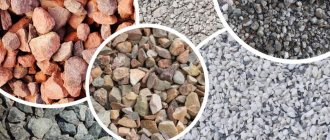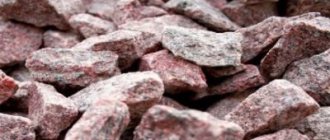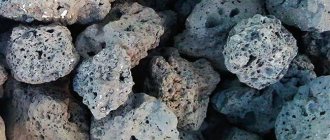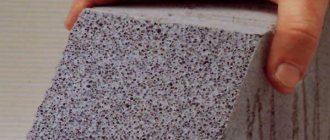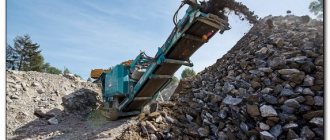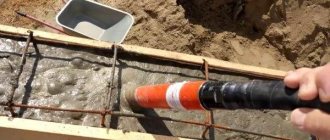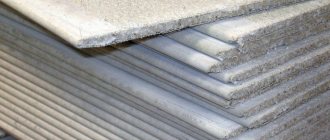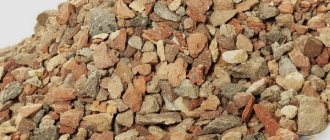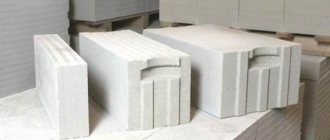Crushed granite 20-40. Photos of Soil Trucks
Crushed stone is a popular construction bulk material, the popularity of which is due to many advantages. One of which is the variety of types of crushed stone . Each variety has its own advantages and disadvantages, individual characteristics, which determine the scope of application of crushed stone. Certain types are reviewed and analyzed in this article. The text also contains links to other publications that provide detailed information about the most popular species.
Extraction and production, composition
In most cases, crushed stone is obtained by crushing rocks of various types : igneous, sedimentary, metamorphic. Extraction is carried out in quarries, open pit.
Quarry development is carried out in several stages, during which the rock is destroyed into separate large fragments. Production begins with crushing and sorting raw materials into separate groups according to the size of the fractions.
Marble mining. Photos of Soil Trucks
To determine the characteristics, the products are sent to the laboratory, where tests are carried out, during which the technical and operational properties of crushed stone and its compliance with standards are established . Bulk materials are packaged (not always) and delivered to the point of sale.
Some types of crushed stone are not produced from raw materials of natural origin; they are artificial products obtained from the processing of construction waste and metallurgical slag.
Depending on the source raw material, the mineral and chemical composition of crushed stone varies. The fractional composition of different species does not differ so significantly:
- screenings - particles 0-5 mm in size;
- crumbs - 3-5 mm;
- fine fraction: 3-8 (so-called Eurocrushed stone); 3-10; 5-10; 5-15; 5-20; 5-25; 10-15; 10-20 and 15-20;
- middle fraction: 20-40; 20-70; 20-80 and 25-60;
- large fraction: 40-70; 40-80; 70-120; 80-120 and 70-200.
Reference. Not all fractions are inherent in each type of crushed stone. In addition, fractions differ into basic (standard) and non-standard.
What does it mean
A fraction is a part of a solid bulk material (for example, sand, gravel, crushed stone) or a liquid mixture (cement). Sorting of crushed stone, carried out during the production process, is carried out on special equipment. The “screen” machine is a set of sieves with cells of different sizes . As a result, the manufacturer receives products from several groups and fractions. Marking of crushed stone in accordance with fractions represents the range of grain sizes, i.e. minimum and maximum value, measured in millimeters, for example, 5-20 (mm.).
Characteristics
Crushed stone of any type has certain characteristics and properties. However, indicators differ depending on the type of feedstock, extraction and production technologies.
Limestone crushed stone 20-40. Photos of Soil Trucks
When choosing crushed stone for certain work, you should pay attention to the following parameters:
- flakiness - the percentage of grains of needle-shaped and lamellar (flaky) forms, which have low strength, absorb water and reduce the overall quality of the product; five groups of crushed stone are distinguished by flakiness: 1st - cuboidal, 2nd - improved, 3rd - normal, 4 1st - regular and 5th - regular;
- specific gravity (bulk density) - the mass of one cubic meter excluding air voids and pores;
- frost resistance - the number of freezing and thawing cycles that a material can withstand without significant loss in mass;
- strength - a characteristic demonstrating the resistance of crushed stone to mechanical stress;
- adhesion - the ability of crushed stone to adhere to bituminous binders;
- radioactivity is an indicator indicating the possibility of using crushed stone for various works.
These characteristics are the main, most important. However, when choosing, you should take into account all properties.
Strength
Strength is a characteristic (grade) that means the resistance of a material to mechanical stress.
The strength of crushed stone is indicated by the letter “M” and a number. The figure is not the impact on crushed stone in kilograms, as is often (and erroneously) indicated in many sources. Assigning an indicator is more complicated. To determine the strength of a material, a mechanical (crushing) effect is applied to it in a cylinder.
The force of impact depends on the diameter of such a device. So, for a cylinder with a diameter of 75 mm, the force is 5,000 kg per second. For a device with a diameter of 150 mm, the impact force is 20,000 kg per second. Next, the percentage of mass loss of crushed stone after crushing is determined. In turn, this percentage and the values permissible by GOSTs indicate that the material belongs to a specific brand in terms of strength.
The following strength grades are available:
- M200
- M300
- M400
- M600
- M800
- M1000
- M1200
- M1400
In turn, brands are divided into the following groups:
- High strength (M1200-1400)
- Durable (M800-1200)
- Medium strength (M600-800)
- Weak strength (M300-600)
- Very weak strength (M200)
Simply put, low-strength crushed stone will turn into dust if a caterpillar tractor drives over it, but high-strength crushed stone will not lose its properties. Therefore, this characteristic is important for construction, road, industrial and engineering work.
There are works in which the strength of crushed stone is not particularly important. First of all, this concerns the use of the material in landscape design (decorating flower beds, designing an alpine slide). A striking example here is marble crushed stone. Its strength characteristics are average; the rock index in the Sverdlovsk region is M600. But since its main sphere is decorative, they buy it based on other qualities.
Where it is used, areas of application
Crushed stone is one of the components of asphalt concrete. Photos of Soil Trucks
Crushed stone of various types is used in the following fields of activity:
1) Construction: for the production of concrete, for the arrangement of drainage systems, for decluttering, for the construction of foundations and road surfaces, for filling sites and parking lots, for leveling areas, for butting fence posts.
2) Road work: for dirt, asphalt and railway roads, for asphalt.
3) Landscape design: creation of alpine slides, dry streams, gabions, design of ponds and flower beds.
4) Production of reinforced concrete products and paving slabs.
S-4 and other types of crushed stone-sand mixture
Crushed stone-sand mixture (alternative names: sand-crushed stone mixture, ShchPS, PShchS, crushed stone-sand) is a bulk construction material that contains sand and crushed stone in different proportions. It is believed that the proportions should be 50 to 50, but the content of materials in the mixture depends on several factors.
In accordance with the grain composition, several types of chipboard are distinguished, each of which is designed to perform specific work. In accordance with GOST, mixtures are divided into three groups:
1)For coatings:
- C1, fractions 0-40 , the percentage of large grains does not exceed 10%, is used for the construction of coatings that must have a perfectly flat surface, for example, for the construction of runways;
- C2, fractions 0-20 , is used for the construction of landing strips, roads of categories I-III, the finished coatings are resistant to water, temperature changes and mechanical loads.
PShchS granite. Photos of Soil Trucks
2) For bases (continuous granulometry):
- C3, sieving of large fractions 0-120 , installation of additional layers during the construction of road surfaces, the use of the mixture allows saving asphalt concrete;
- C4, fractions 0-80 , the content of large grains is no more than 10%, is considered one of the most popular materials, popular in the construction of highways, creating ballast cushions for tram and railway tracks, strengthening roadsides;
- C5, fractions 0-40 , is used in the construction of roads for various purposes, strengthening roadsides, and the construction of civil and industrial buildings;
- C6, fractions 0-20 , is used in residential, industrial and road construction, especially actively used for forming cushions for road surfaces;
- C7, fractions 0-10 and C8, fractions 0-5 , fine mixtures are used for the construction of cushions (lower layers) of road surfaces.
3) For bases (discontinuous granulometry):
- C9, fractions 0-80 , is used for the construction of roads and parking lots, strengthening roadsides;
- C10, fractions 0-40 , popular at the initial stage of highway construction;
- C11, fractions 0-20 , the main area of application is road construction.
What are the varieties, classification
There are several criteria according to which it is possible to classify crushed stone.
By origin: broken and so on
Basalt crushed stone. Photos of Soil Trucks
The greatest demand is for crushed stone, the raw materials for which are rocks, less often minerals , that is, materials of natural origin. The most common among them are:
- durable universal granite crushed stone, sold at high prices in comparison with analogues;
- affordable gravel with low radioactivity;
- marble and quartz are highly valued by landscape designers;
- limestone and dolomite - materials, the difference between which is often not seen by both clients and specialists;
- basalt, which is used to solve a wide range of problems, including for the arrangement of the ballast layer of railway tracks and highways;
- slate can vary significantly in strength, which is important to consider when purchasing;
- expanded clay and agloporite - types that are similar in appearance, but differ in characteristics;
- slag and secondary (the name “broken” is less common) are sold at affordable prices, as they are produced from metallurgy and construction waste;
- recently in demand foam glass.
Quartzite
Quartzite (quartzite) crushed stone is obtained by crushing the metamorphic rock of the same name. The basis of quartzite is quartz (more than 90%) and admixtures of various minerals . Quartzite is a durable and difficult to process mineral, which in most cases is white or gray in color, but other shades are also found. Crushed stone has the following characteristics:
- strength grade M1400;
- abrasion grade - I-1;
- water absorption is 0.15%;
- frost resistance - F300;
- flakiness does not exceed 8%, belongs to the first cuboid group;
- bulk density averages 1400 kg/cub.m.;
- content of dust and clay impurities - up to 2%;
- recognized as one of the most environmentally friendly materials, since it has no natural background radiation, which allows it to be classified as first class.
Quartzite (quartzite) crushed stone. Photos of Soil Trucks
It is the absence of background radiation and excellent performance characteristics that contribute to the active use of quartzite crushed stone in the construction of residential buildings, schools, hospitals, kindergartens, office buildings and structures for other (any) purposes. is used in construction .
Medium fraction 20-40 is suitable for projects in road construction and when creating runways.
Coarse-grained is used for the manufacture of concrete, when creating ballast layers, in industrial construction.
Quartzite crushed stone of different fractions is used in decorative and facing works, and in the production of paving stones.
Sandstone
Crushed sandstone is a material obtained by crushing homogeneous or layered dense rock , formed from grains of sand held together by various mineral components. Sandstone formation takes place over several millennia. Strength directly depends on its composition, or more precisely, on the substance with which the grains of sand are held together. These can be clay, siliceous, carbonate, lime, gypsum, ferruginous or other binders. The color also depends on them.
Gray and gray-blue crushed stone belongs to strength grades M1000-M1200, and sometimes 1400, brown and red - 600-800, beige, gray-green, terracotta-red - 200-400.
Reference. Sandstone, which contains carbonate or siliceous binders, is the most effective in terms of physical and mechanical characteristics.
Density varies within small limits - from 2250 to 2670 kg/cub.m.
Sandstone belongs to the first class in accordance with radioactivity.
The fire resistance indicator inherent in the material is variable, the maximum value corresponds to 1700 degrees Celsius.
High-quality crushed stone is distinguished by a minimum content of weak rock grains and the highest adhesive properties.
In addition, sandstone has other positive properties:
- low flakiness;
- resistance to temperature changes, that is, high frost resistance;
- low water absorption coefficient;
- practically not subject to weathering;
- does not fade as a result of exposure to direct sunlight;
- quite low cost.
The above characteristics allow sandstone to be successfully used in many areas:
- fine fraction 5-20 is in highest demand, used in the manufacture of concrete and concrete structures, in the construction of foundations, when pouring bridge elements, road surfaces and foundations;
- the middle fraction 20-40 is used in the production of reinforced concrete structures, the construction of roads and railways, the construction of industrial buildings, and for foundation cushions;
- the large fraction 40-70 is used in the construction of massive concrete structures and in road construction.
Sandstone of various fractions is also used in landscape design, where the choice of grain size depends on the tasks.
Andesitic, what kind of material is it and more
Andesite crushed stone is obtained from an igneous rock of a similar name. The first mining of andesite was carried out in the Andes, on the steep slopes of the mountains, hence the name of the rock. Deposits look like layers of rock . The correctness of the forms is an important advantage of the rock, which was the reason for the use of andesite as a facing material . The rock is formed as a result of the solidification of volcanic magma on the surface of the earth. The main element of andesite is silica, its amount exceeds 50% . The breed is gray, dark gray or black in color.
Andesite. Photos of Soil Trucks
The rock and the crushed stone produced from it by crushing and sorting have a fine-grained porous structure with a large number of mineral inclusions and a rough surface. The compressive strength varies widely - from 600 to 2500 kg/sq.cm. Volumetric weight is approximately 2500 kg/cub.m.
Andesite crushed stone is actively used for the production of acid-resistant concrete, which demonstrates its high strength and resistance to external adverse influences. The material is also used in the construction of roads, residential and industrial buildings, railway tracks, and the production of reinforced concrete structures.
River
This type of crushed stone does not exist. However, gravel can be classified as river bulk materials. The raw material for production is sedimentary rock. Gravel is formed by the natural breakdown of rocks and minerals. Gravel can be river, lake, sea, mountain, or glacial.
Crushed stone. Photo revda-shcheben.rf
Color: gray and so on
Crushed stone comes in a variety of colors and shades. In most cases, the material is associated with a gray color, since many types have this color:
- granite - gray with splashes;
- gabbro - uniform gray;
- dolerite, diabase, serpentinite - dark gray;
- limestone - light gray;
- marble, shungite and pyroxenite - gray.
Fractions of marble crushed stone. Photo Petrovich
Often the fractions are black, white, beige, brown, yellow and others. A variety of natural colors allows you to choose the best option for solving any problems where color plays an important role.
Weight
There are volumetric and specific gravity ; when calculating the first indicator, air voids are taken into account, the second is not. Both values are influenced by several components : rock, fraction size, rock density, flakiness, humidity. It is possible to calculate the weight yourself, but in this case there is an error of approximately 10% . Therefore, you should rely on official reference data on weight.
Form of release and sale: in bags and others
Crushed stone is sold in several “forms”: in bulk (by weight, in tons), in bags with a capacity of no more than 50 kilograms and big bags - soft containers with handles weighing 1000 kg. Thus, both legal entities and individuals have the opportunity to purchase the required amount of bulk materials.
Crushed gravel fraction 5-20 1000 kg. Photo by Leroy Merlin
By post-processing method: washed (washed), tumbled, black, colored
There are several types of crushed stone in accordance with the post-processing method. Ready crushed stone, that is, already crushed and sifted into fractions, can be subjected to additional processing.
Black rubble. Photos of Soil Trucks
1) Black crushed stone, often called bitumen, is a material that, after extraction, is covered with binders. Crushed stone from dense rocks is used as raw material: granite, limestone, marble, gravel. This variety, despite its high cost, is of increased interest, so black crushed stone is discussed in detail in a separate article.
2) Colored is artificially colored crushed stone, the production technology of which consists of impregnation with acrylic or polymer paints and drying. As a result, it is possible to obtain fractions of non-standard colors for use in landscape design, details here.
3) Washed. Crushed stone mined in quarries contains a significant amount of sand, clay, and impurities. To achieve the necessary conditions for purity, the material is additionally processed. Several types of equipment are used for washing. First of all, it can be stationary and mobile. Equipment is divided depending on the design:
a) Various types of washers: trough, saber, vibrating and auger - are used to clean raw materials contaminated with hard-to-wash clay. Most often, trough installations are used, which are troughs with bladed shafts into which water is poured. The blades mix the material and cleaning is carried out.
b) Drum units are designed to work with heavily contaminated raw materials. Drum sets have blades inside. Crushed stone is loaded into the installation, water is poured in, and rotation begins. Cleaning is carried out as a result of friction of fractions against each other. Drum installations provide high-quality washing, the crushed stone does not get damaged. But high-performance installations consume large volumes of water.
c) The irrigation screen is a container with nozzles for supplying water. During the washing process, sorting is also performed. Operation of this equipment does not guarantee the quality of work performed.
Species of different origins are washed. Therefore, it is difficult to give specific characteristics of washed crushed stone. The areas of application can be noted in general terms. Crushed stone is used for the production of concrete solutions, used in road construction and runway construction, in the preparation of asphalt, for decorative finishing, and for road filling.
Colored crushed stone. Photos of Soil Trucks
A procedure such as flushing is not very popular for several reasons:
- labor intensity of work;
- low productivity;
- high price.
4) Galvanized (polished) crushed stone is most often produced according to the client’s order. There are two reasons - the process of obtaining such material is lengthy and financially expensive . Tumbling is a mechanical treatment, as a result of which crushed stone is cleaned of foreign impurities and sharp and uneven edges are smoothed (polished).
Tumbling is carried out in special drums, which are large cylinders with jagged walls. Crushed stone, cleaning agents, metal balls and water are placed in the drum. The duration of tumbling depends on the strength of the rock. The stronger the material, the longer it will take to sand. Various rocks and minerals are processed : sandstone, marble, granite, serpentine (serpentinite). The finished product looks like pebbles. Galvanized crushed stone is valued for its attractive appearance and affordable cost , and also has other advantages:
- has all the properties of natural stone;
- has a rich color and more pronounced texture;
- low water absorption coefficient;
- the ability to create stone for specific tasks;
- Wide range of applications, crushed stone is used in landscape design, for the design of garden plots, park areas and streets, and in interior design.
Stamps
Some characteristics provide classification of crushed stone into individual grades:
- by strength: M200, M300, M400, M600, M800, M1000, M1200 and M1400;
- by frost resistance: F15, F25, F50, F100, F150, F200, F300 and F400;
- by abrasion: I1, I2, I3 and I4.
- by moisture resistance: B1, B2 and B3.
Slate crushed stone. Photos of Soil Trucks
The division of material into brands is of increased interest to Internet users, so a separate article is devoted to this topic.
Rounded
There is no such type as rounded crushed stone. This term applies to gravel, which is a type of sedimentary rock. The material is included in the grinding group, the materials of which are divided into rounded and unrounded. Gravel is a rounded, loose material.
Categories: cuboid and other
One of the main characteristics is flakiness. Based on the amount of flakier grains, five groups are distinguished:
The first is cube-shaped - the grain content does not exceed 10%, high-quality crushed stone is used for the production of reinforced concrete products and concrete, which requires the highest performance characteristics.
Crushed slag stone. Dune Photos
The second - improved - 10-15, crushed stone has fairly high performance characteristics, which ensures its use in construction and the production of concrete and asphalt.
The third is normal (or usual) - 15-25. The material is suitable as a filler for concrete, but a fairly high content of flakier grains increases cement consumption and does not guarantee good adhesion. Crushed stone does not lend itself well to compaction during road construction. Therefore, the material is recommended for use in the construction of the lower layers of the canvas, which will then be amenable to splitting with crushed stone with a higher flakiness. Without restrictions, fractions can only be used for filling.
The fourth is regular - 25-35, fractions are suitable for backfilling, construction of temporary and low layers of dirt roads.
The fifth is ordinary - 35-50, the product is recommended for the construction of temporary roads and platforms for the movement of construction equipment, suitable for solving decorative problems.
Asphalt
The term “asphalt” crushed stone can mean two types of material:
1) crushed stone obtained by processing asphalt is one of the types of secondary materials;
Recycled crushed stone. Photos of Soil Trucks
2) crushed stone suitable for making asphalt concrete ; It is recommended to choose stones from rocks of igneous origin: granite, basalt, diorite, gabbro, diabase, syenite; amphibolite and sepentinite are good options.
Types of crushed stone for construction work
The main production sites for crushed stone are open pits, slopes, cliffs and the seabed. Open pit mining is the cheapest method of extraction and processing. In some cases, blasting operations are carried out, then, using simple equipment, the material is sorted and shipped to the consumer.
There are three types of crushed stone:
- granite;
- gravel;
- limestone.
Additionally, you can point to secondary and slag crushed stone. This option is obtained after dismantling objects and when smelting ore in metal production. But their use is not extensive due to heterogeneity; such a mass must be compacted carefully and for a long time. Such materials are not used on objects with heavy loads.
Granite crushed stone is the strongest, most durable, and extraction is associated with increased energy costs. Blasting operations are often used and heavy equipment is involved, so the cost of raw materials is higher than others. It has an increased, permissible level of radioactivity, despite this, it is in constant demand.
Crushed gravel has similar characteristics, but the strength is inferior to the previous type. A special feature is the low level of radioactivity, which expands the scope of use.
Limestone crushed stone is the most affordable, has low strength, and therefore is not used in places with future load. However, limestone pyramids have been known to mankind for a long time; they still amaze tourists.
Where can I buy
Manufacturing companies and suppliers, some of which are represented here, offer a wide range of bulk materials. You can view the list and purchase crushed stone on the website or by contacting company employees.
Types · 01/28/2021 · 0
How to determine
Determination of the grain (granulometric) composition of crushed stone is determined in laboratory conditions. To do this, a sample of crushed stone of a certain mass is formed, which is dried and scattered on a set of sieves with holes of certain sizes. Perform these procedures yourself, i.e. at home, it won't work. Therefore, we will not dwell on this in detail. In addition, a separate publication is devoted to the composition of crushed stone and methods for determining it.
